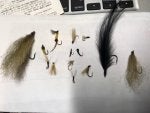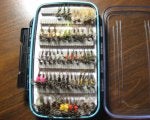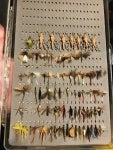tcorfey
Well-known member
Lately I have been getting in to tying basic thread body flies as I find it so interesting and effective way to tie flies that not look great but definitely catch fish. I had learned a couple of new ways to adorn basic thread bodied flies to achieve different results and I was thinking this is a great way to get beginners going on fly tying and I enjoy making a "family" of flies based on a standard body color.
I am referring to simply tying the thread body by wrapping the thread (color of your choice) from the eye to the curve of the shank and back up the shank towards the eye then use different materials to finish the fly for example take a few elk hair fibers and tie them in as a wing towards the shank and you have a great dry caddis imitation. If you reverse the wing so it goes over the hook eye instead of down the shank you now have an emerger, These flys are so simple yet very effective.
Or instead of tying in elk hair, tie in a hackle feather for a hackled dry fly (add a few hackle fibers for a tail if you feel adventurous). or instead you can tie in a soft hackle style to make a wet fly.
Or maybe forget the wing and tie in a peacock hurl collar instead, and/or perhaps add a bead head for a deadly nymph pattern (I find a yellow thread bodied fly with a peacock hurl collar to be especially deadly at certain times on the McCloud river in California).
I rarely hear people talk about this simple yet effective style of tying flys but, the great thing is they are so easy to tie and they work! I thought some beginner fly tiers out there would especially appreciate this suggestion and maybe others would like to add more to this subject.
Regards,
Tim C.
I am referring to simply tying the thread body by wrapping the thread (color of your choice) from the eye to the curve of the shank and back up the shank towards the eye then use different materials to finish the fly for example take a few elk hair fibers and tie them in as a wing towards the shank and you have a great dry caddis imitation. If you reverse the wing so it goes over the hook eye instead of down the shank you now have an emerger, These flys are so simple yet very effective.
Or instead of tying in elk hair, tie in a hackle feather for a hackled dry fly (add a few hackle fibers for a tail if you feel adventurous). or instead you can tie in a soft hackle style to make a wet fly.
Or maybe forget the wing and tie in a peacock hurl collar instead, and/or perhaps add a bead head for a deadly nymph pattern (I find a yellow thread bodied fly with a peacock hurl collar to be especially deadly at certain times on the McCloud river in California).
I rarely hear people talk about this simple yet effective style of tying flys but, the great thing is they are so easy to tie and they work! I thought some beginner fly tiers out there would especially appreciate this suggestion and maybe others would like to add more to this subject.
Regards,
Tim C.




